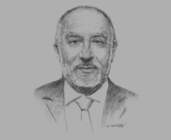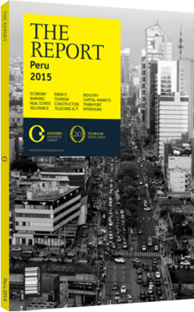Eleodoro Mayorga, Minister of Energy and Mines: Interview

Interview: Eleodoro Mayorga
What is the exploration strategy to raise oil production from 65,000 barrels per day (bpd)?
ELEODORO MAYORGA: Production has been dropping since 1980, when Peru reached its peak of 200,000 bpd. This tendency has been reversed due to new exploration, mainly in heavy crude. The new pits, located mostly in the northern jungle area, are not yet producing at their full potential. Over the next four years production will rise significantly with extraction from blocks 67 and 39 from Perenco, block 126 from Cepsa, block 95 from Gran Tierra and block 131 from Pacific Rubiales.
The activation of just half these projects will see production top 100,000 bpd in 2020. We have not managed to increase investment in hydrocarbons exploration, but the upcoming rounds will reactivate the sector. Combined with the new environmental law, this will help invigorate the industry and Peru will be able to reach its jungle and offshore potential. There is no lack of private companies interested in exploration, so we just need to adapt the regulatory framework.
How is the Sur Peruano Pipeline likely to affect energy stability in the country?
MAYORGA: Our economy will continue to grow at rates of 5-6%, which means that energy demand is increasing one or two points above this. In turn, this means that energy infrastructure needs to be doubled every 10 years. This includes generation, transmission and distribution. So we have to diversify our energy mix. Although the country has great potential for hydro, wind and solar energy, the cheapest source is still natural gas. Existing reserves are sufficient to supply demand for the next 30 years. The country has the potential for more than 70,000 MW of hydroelectricity, and at the moment we are using less than 30%.
The pipeline will have a direct impact on improving the economy of the country’s southern regions, which are the poorest and most populated. This energy security will guarantee sustainable growth and promote industrialisation, with a focus on petrochemicals. from 90% a decade ago. What is the ideal balance?
MAYORGA: The plan is to have an energy mix focused on hydro and gas plants, with around 50% coming from each. With two new 750-MW gas-fired stations being built to satisfy demand from the Sur Peruano Pipeline, in the next few months there will be a tender for a 1200-MW hydro plant to help maintain the energy balance. Peru has potential for wind, solar and geothermal power, so the strategy is to focus on acquiring new technology in this decade and to start introducing them to the energy matrix from 2020 onwards.
Electricity demand is forecast to increase by 5% annually for the next 20 years. How will you cope?
MAYORGA: We are confident that current gas production provides capacity to supply affordable power even if the demand were to be double that of today.
The key is to become more efficient and work on generating aggregated value. Alternative power sources must play a major role in this.
As for transmission, we are developing a 500-KV power line which, combined with the pipelines, will provide the basis for a much more dependable electricity system. This will not only provide energy stability but will also open the market to export to neighbouring countries. Even the highest estimated demand leaves a significant generation surplus.
The national environmental certification service, SENACE, was meant to improve efficiency in regard to environmental impact assessments (EIAs), but there are frequent delays. Is a rethink needed?
MAYORGA: With Peru undergoing environmental institutionalisation, SENACE needs to play an important role in creating the basis for faster and clearer regulation to obtain EIAs. However, the organisation is still relatively new, and it needs time to adapt. There is no need to rethink the concept of the institute, but we do have to give it the necessary tools to do its work properly.
What is the exploration strategy to raise oil production from 65,000 barrels per day (bpd)?
MAYORGA: Production has been dropping since 1980, when Peru reached its peak of 200,000 bpd. This tendency has been reversed due to new exploration, mainly in heavy crude. The new pits, located mostly in the northern jungle area, are not yet producing at their full potential. Over the next four years production will rise significantly with extraction from blocks 67 and 39 from Perenco, block 126 from Cepsa, block 95 from Gran Tierra and block 131 from Pacific Rubiales.
The activation of just half these projects will see production top 100,000 bpd in 2020. We have not managed to increase investment in hydrocarbons exploration, but the upcoming rounds will reactivate the sector. Combined with the new environmental law, this will help invigorate the industry and Peru will be able to reach its jungle and offshore potential. There is no lack of private companies interested in exploration, so we just need to adapt the regulatory framework.
How is the Sur Peruano Pipeline likely to affect energy stability in the country?
MAYORGA: Our economy will continue to grow at rates of 5-6%, which means that energy demand is increasing one or two points above this. In turn, this means that energy infrastructure needs to be doubled every 10 years. This includes generation, transmission and distribution. So we have to diversify our energy mix. Although the country has great potential for hydro, wind and solar energy, the cheapest source is still natural gas. Existing reserves are sufficient to supply demand for the next 30 years. The country has the potential for more than 70,000 MW of hydroelectricity, and at the moment we are using less than 30%.
The pipeline will have a direct impact on improving the economy of the country’s southern regions, which are the poorest and most populated. This energy security will guarantee sustainable growth and promote industrialisation, with a focus on petrochemicals.
Around 55% of energy comes from hydro, down from 90% a decade ago. What is the ideal balance?
MAYORGA: The plan is to have an energy mix focused on hydro and gas plants, with around 50% coming from each. With two new 750-MW gas-fired stations being built to satisfy demand from the Sur Peruano Pipeline, in the next few months there will be a tender for a 1200-MW hydro plant to help maintain the energy balance. Peru has potential for wind, solar and geothermal power, so the strategy is to focus on acquiring new technology in this decade and to start introducing them to the energy matrix from 2020 onwards.
Electricity demand is forecast to increase by 5% annually for the next 20 years. How will you cope?
MAYORGA: We are confident that current gas production provides capacity to supply affordable power even if the demand were to be double that of today.
The key is to become more efficient and work on generating aggregated value. Alternative power sources must play a major role in this.
As for transmission, we are developing a 500-KV power line which, combined with the pipelines, will provide the basis for a much more dependable electricity system. This will not only provide energy stability but will also open the market to export to neighbouring countries. Even the highest estimated demand leaves a significant generation surplus.
The national environmental certification service, SENACE, was meant to improve efficiency in regard to environmental impact assessments (EIAs), but there are frequent delays. Is a rethink needed?
MAYORGA: With Peru undergoing environmental institutionalisation, SENACE needs to play an important role in creating the basis for faster and clearer regulation to obtain EIAs. However, the organisation is still relatively new, and it needs time to adapt. There is no need to rethink the concept of the institute, but we do have to give it the necessary tools to do its work properly.
You have reached the limit of premium articles you can view for free.
Choose from the options below to purchase print or digital editions of our Reports. You can also purchase a website subscription giving you unlimited access to all of our Reports online for 12 months.
If you have already purchased this Report or have a website subscription, please login to continue.

